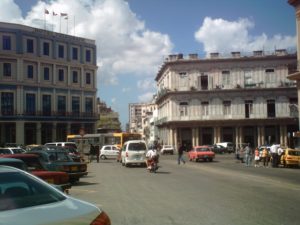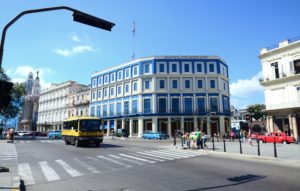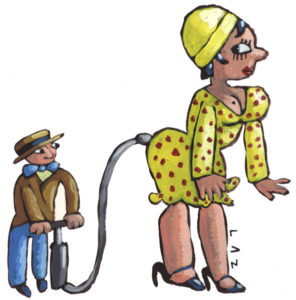 LA ESQUINA DE PRADO Y NEPTUNO, “LA ENGAÑADORA” Y NINÓN MONDEJAR.
LA ESQUINA DE PRADO Y NEPTUNO, “LA ENGAÑADORA” Y NINÓN MONDEJAR.
Cuando el 27 de Enero de 2006, con la muerte en la Habana del Maestro Ninón Mondejar, director de la Orquesta América, se cerró un capitulo más de la Historia Musical de nuestro pais, sus intérpretes y sus precursores. Un ciclo que comenzára con una composición musical y un nuevo ritmo que hicieran girar a la conocida esquina habanera de Prado y Neptuno sobre el mundo.
A este milagro musical de entonces se le llamó cha-cha-chá y su creador no fue otro que el director musical de esta orquesta y primer violinista, el maestro Enrique Jorrín, quien dejara inscrito, más que un género, su sello propio, y que le colocaría entre las glorias de la música cubana.
El experimento se gestó en la famosa esquina habanera, en las asociaciones “Prado y Neptuno” y “Silver Star”, en uno de sus salones de baile, “Amores de Verano”. Es precisamente en esta sala donde por primera vez se ejecuta la pieza musical que comenzaría toda una época del fenómeno rítmico.
“La Engañadora”, el primer número musical en cha-cha-chá escrito por Jorrín, deja en pocos meses impreso en los anales nacionales, y después en todo el mundo, el sello propio de esta gloria de la música cubana que fuera Enrique Jorrín.
Un ritmo pegajoso y atractivo el cha-cha-chá, según explica el mismo Jorrín… En él “combiné figuras simples, como las negras, blancas y corcheas en compás de 2/4. Suprimo el cinquillo, convirtiendo el ritmo básico del género al esquema no sincopado ejecutado por el guayo, el cencerro y la tumbadora”.
A medio siglo del triunfo mundial del cha-cha-chá, echemos una ojeada sobre este ritmo popular que recorrió el mundo e inmortalizó a una de las esquinas más famosas de La Habana, y que puso a La Habana otra vez en la cadencia musical de sus intérpretes y bailadores desde Buenos Aires hasta Tokio, donde el maestro Enrique Jorrín lleva su música.
¿Quién fue la Engañadora.? ¿De dónde salía aquella mujer que puso el mundo a gozar y convirtió a la famosa esquina Prado y Neptuno en el foco musical de toda una época..? ¿Cuál es el origen de la Engañadora..?
Según algunas fuentes, el maestro Jorrín se inspiró en una muchacha que un día pasó ante él y un grupo de hombres que conversaban en la esquina de las calles Infanta y Sitios, en La Habana. Ante el desprecio con que la muchacha les miró, uno de los admiradores le dijo: “Tanto cuento y cuando viene a ver son de goma”. En otra ocasión en que Jorrín se encontraba en el desaparecido salón de bailes situado en la esquina de Prado y Neptuno, entró una muchacha delgadita pero que ostentaba un voluminoso trasero. Una moda artificial muy usual en la época. Enseguida le pasó por la mente la pregunta: “¿Esta será otra engañadora? ¿Usará postizos?”.
Lo cierto de todo esto es que el ritmo y “La Engañadora” conquistarían en poco tiempo todo el continente, el mundo bailaba el majestuoso cha-cha-chá, que hoy se mantiene saludable, lleno de vida y de energía como sólo un ritmo del trópico y la creación del maestro Jorrín pudieran alcanzar.
En aquel entonces en Cuba había 10.000 vitrolas, alrededor de 100 emisoras de radio, varios canales de televisión —por donde se emitían magníficos programas como “El Cabaret Regalías” de la CMQ— y un sinnúmero de locales y establecimientos donde se reunía el pueblo para escuchar música y bailar.
“La Engañadora” fue el primer triunfo del maestro Jorrín grabado con el sello Panart, compañía que pasaba por problemas financieros en esos momentos. La grabación traía del otro lado “Silver Star”, que acompañó triunfalmente también al nacimiento del nuevo ritmo.
Al igual que Jorrín, muchos intérpretes de la música cubana ya no están entre nosotros, pero los recuerdos de su herencia musical para siempre estarán aquí. Nuevas generaciones ocuparán nuestros puestos bailables, es precisamente para que esto continúe sucediendo, motivo principal de este sentido y merecido homenaje a la memoria del maestro Enrique Jorrín.
 THE CORNER OF PRADO AND NEPTUNO, “THE DECEIVER” (LA ENGAÑADORA”) AND NINÓN MONDEJAR.
THE CORNER OF PRADO AND NEPTUNO, “THE DECEIVER” (LA ENGAÑADORA”) AND NINÓN MONDEJAR.
When on January 27, 2006, with the death in Havana of Maestro Ninón Mondejar, conductor of the Orquesta América, one more chapter of the Musical History of our country, its interpreters and its precursors was closed. A cycle that began with a musical composition and a new rhythm that would turn the well-known Havana corner of Prado and Neptune over the world.
This musical miracle of that time was called cha-cha-chá and its creator was none other than the musical director of this orchestra and first violinist, maestro Enrique Jorrín, who left inscribed, rather than a genre, his own label, and that would place him among the glories of Cuban music.
The experiment was organized in the famous Havana corner, in the “Prado and Neptune” and “Silver Star” associations, in one of its dance halls, “Summer Loves.” It is precisely in this room where for the first time the musical piece is played that would begin an entire era of a rhythmic phenomenon.
“La Engañadora”, the first musical number in cha-cha-chá written by Jorrín, leaves in a few months printed in the national annals, and then worldwide, the hallmark of this glory of Cuban music that was Enrique Jorrín.
A sticky and attractive rhythm the cha-cha-chá, as Jorrín himself, explains … In it “I combined simple figures, such as black, white and eighth notes in 2/4 measures. I suppress the cinquillo, converting the basic rhythm of the genre to the non-syncopated scheme executed by the guayo, the cowbell and the tumbadora ”.
Half a century after the world triumph of cha-cha-chá, let’s take a look at this popular rhythm that traveled the world and immortalized one of the most famous corners of Havana, and that put Havana again in the musical cadence of its interpreters and dancers from Buenos Aires to Tokyo, where maestro Enrique Jorrín takes his music.
Who was the Deceiver? Where did the woman who put the world to enjoy and turned the famous Prado and Neptune corner into the musical focus of an era …? What is the origin of the Deceiver ..?
According to some sources, the teacher Jorrín was inspired by a girl who one day passed before him and a group of men who talked in the corner of Infanta and Sites streets, in Havana. Faced with the contempt with which the girl looked at them, one of the fans said: “So much story and when it comes to see are rubber.” On another occasion when Jorrín was in the missing ballroom located on the corner of Prado and Neptune, a thin girl entered but had a bulky butt. A very usual artificial fashion at the time. The question immediately came to mind: “Will this be another deceiver? Will you use hairpieces? ”
The truth of all this is that the rhythm and “The Deceiver” would soon conquer the entire continent, the world danced the majestic cha-cha-chá, which today remains healthy, full of life and energy as just a rhythm of the Tropic and the creation of Master Jorrín could reach.
At that time in Cuba, there were 10,000 inlets, about 100 radio stations, several television channels – where magnificent programs such as “The Cabaret Regalías” of the CMQ were broadcast – and countless places and establishments where the town met to listen to music and dance.
“The Deceiver” was the first triumph of the teacher Jorrín engraved with the Panart label, a company that was going through financial problems at that time. The recording brought “Silver Star” on the other side, which also triumphantly accompanied the birth of the new rhythm.
Like Jorrín, many Cuban music performers are no longer among us, but memories of his musical heritage will forever be here. New generations will occupy our dance positions, it is precisely for this to continue happening, the main reason for this sense and deserved a tribute to the memory of maestro Enrique Jorrín.
Agencies/ Wiki/ Internet Photos/ Extractos/ Excerpts/ YouTube/ Arnoldo Varona/ www.TheCubanHistory.com
THE CUBAN HISTORY, HOLLYWOOD.



 < THE CORNER of Prado y Neptuno, La Havana, "LA ENGAÑADORA" and Ninón Mondejar. VIDEOS.
< THE CORNER of Prado y Neptuno, La Havana, "LA ENGAÑADORA" and Ninón Mondejar. VIDEOS.




